Milking Robots Market by System Type (Single-stall Unit, Multi-stall Unit, Automated Milking Rotary). Herd Size (Below 100, Between 100 and 1,000, Above 1,000), Offering (Hardware, Software, Services), Species, Actuators and Region – Forecast to 2029
[225 Pages Report] The global milking robots market is projected to grow from USD 3.2 billion in 2024 to USD 5.3 billion by 2029, registering a CAGR of 10.8% during the forecast period. The growth of the market is driven by factors such as lower labor costs resulting from automation on dairy farms, technological advancements in dairy farming, and the advantages provided by automatic milking solutions. Adopting advanced technologies and equipment has not only enhanced the efficiency and productivity of livestock farms but has also brought about increased precision and automation. This section delves into the encouraging and challenging factors that impact the global milking robots market. These insights empower market players to formulate strategies and action plans, fortifying their positions in the market.
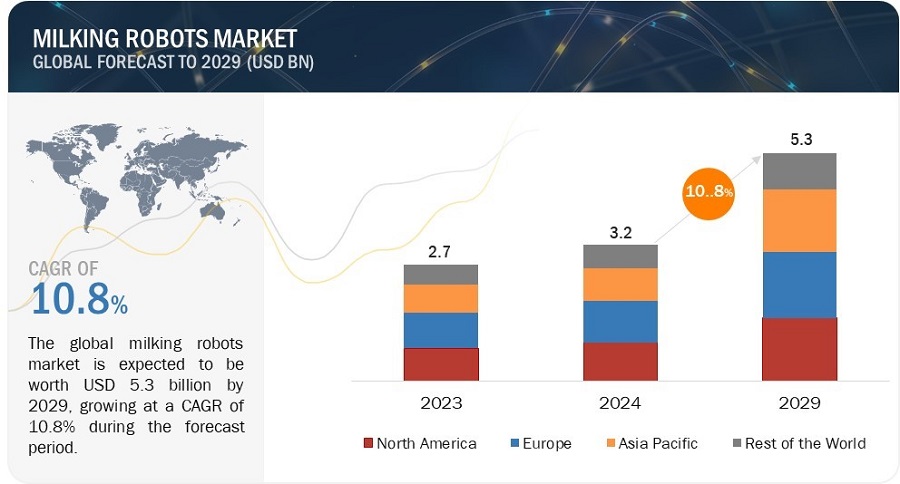
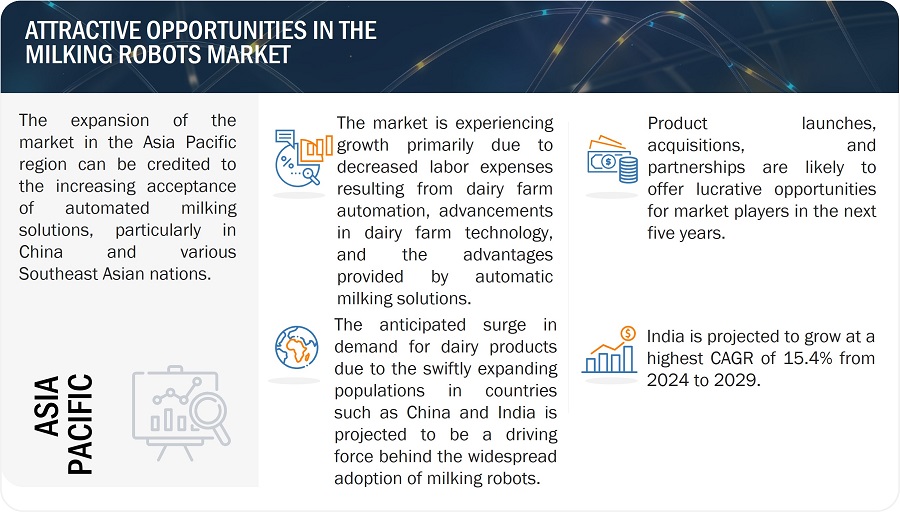
Milking Robots Market Forecast to 2029
To know about the assumptions considered for the study, Request for Free Sample Report
Market Dynamics:
Driver: Cutting labor expenses due to surging adoption of automation in milking farms
The reduction in labor costs attributed to the adoption of automation in milking farms signifies a shift towards more efficient and streamlined processes. With the integration of automated technologies, tasks related to milking and farm management that were traditionally performed manually are now automated. Dairy farming, known for its labor-intensive nature, faces the challenge of rising labor and operational costs globally due to increased demand for dairy products and a subsequent surge in the number of dairy farms. According to the US Department of Agriculture Economic Research (USDA), farm wages saw a significant rise from an annual average of USD 13.32 per hour in 2017 to USD 27.57 per hour in 2022. This increase is influenced by a growth of 25.1% in net farm income from 2020 to 2021. The adoption of milking automation technologies, including milking robots, becomes crucial to address this challenge. Milking robots reduce manual effort and enhance milk yield by allowing more frequent milking of individual animals. This increased efficiency, coupled with the flexibility of not requiring a farmer's presence at every milking, is anticipated to alleviate labor and operational costs in dairy farms.
Restraint: Substantial initial expenditure
The substantial initial investment stands as a prominent obstacle hindering the growth of the milking robots market. The integration of hardware components and technologies, including automation and control devices, as well as sensing and monitoring devices, not only involves upfront installation expenses but also adds to ongoing operational costs. In addition to hardware, the utilization of cloud-based or on-premise software solutions, along with various services like maintenance and support, connectivity, system integration, consulting, managed services, and assisted professional services, significantly contributes to the overall high expenses associated with milking robots. This challenge is particularly pronounced in regions with a prevalence of small to medium-sized farms, where farm owners, especially in emerging economies like India, Brazil, and China, may be cautious about extensive investments in advanced and automated solutions due to potential financial risks, given the relatively low herd size and the unorganized nature of the livestock industry.
Opportunity: Growing adoption of milking robots in developing countries
The adoption of milking robots in developing countries is slow, mainly due to high installation costs, less awareness among farmers about the benefits of milking robots, and small herd size. Robotic milking presents several opportunities for the dairy industry. Firstly, it can improve milk quality and hygiene by ensuring consistent milking protocols, reducing contamination, and leading to safer, higher-quality milk. Secondly, it can boost dairy farm efficiency and productivity by saving time and labor, allowing farmers to focus on other tasks and potentially increase milk production. Thirdly, it can improve cow welfare by reducing stress on cows and leading to better animal health and longevity. Fourthly, it can support small-scale dairy farms in developing countries by making the technology accessible through smaller, more affordable robots. Finally, it can create new economic opportunities through robot manufacturing and installation.
Challenge: Integrating Milking Robots with Grazing Systems and the Need for Standardization
Grazing dairies providing pasture access introduce additional complexities when incorporating milking robots. The process involves enticing cows from pastures to the barn for milking and then returning them to the field for grazing. Managing the herd's movement in and out of the pasture poses a significant challenge for farmers implementing robotic milking systems. Additionally, dealing with the behavioral differences among individual animals during milking presents another substantial difficulty. These behavioral variations make maintaining a consistent milking frequency across the entire herd challenging, potentially affecting milk yield. Moreover, the adoption of milking robots may not be suitable for all cows, particularly those with unfavorable udder shapes and teat positions.
Milking robots Market Ecosystem
Prominent companies in this market include well-established, financially stable providers of milking robots products. These companies have been operating in the market for several years and possess a diversified product portfolio, state-of-the-art technologies, and strong global sales and marketing networks. Prominent companies in this market include Lely (Netherlands), GEA Group AG (Germany), DeLaval (Sweden), Nedap Livestock Management (Netherlands), and BouMatic (US). Other key players include Fullwood JOZ (UK), Milkomax solutions laiteres inc. (Canada), System Happel GmbH (Germany), Waikato Milking Systems NZ LP (New Zealand), AMS Galaxy USA (US), and Dairymaster (Ireland).
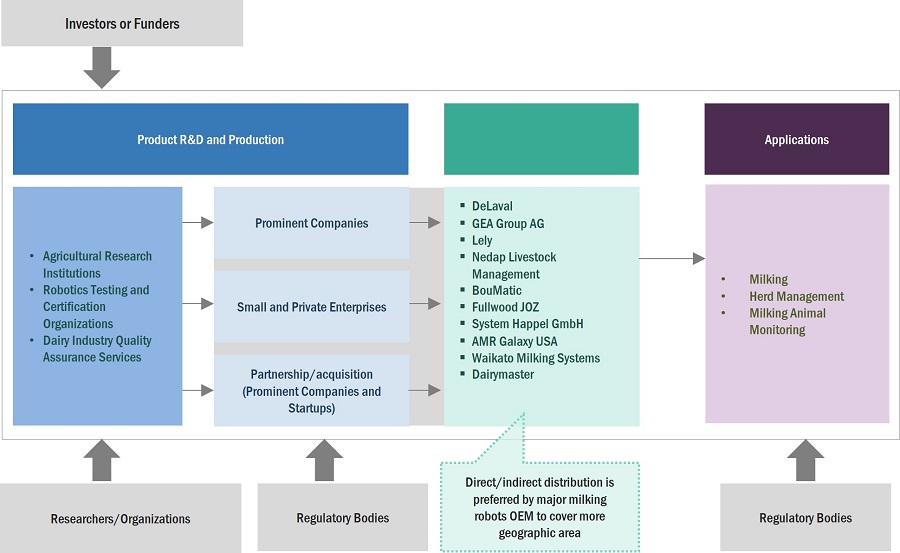
By Farm Size, Farms with herd size above 1000 is likely to grow at the highest rate during the forecast period.
Robotic milking presents several opportunities for large dairy farms with a herd size above 1000 cows. Firstly, it can improve labor efficiency and cost savings by automating milking, reducing personnel needs and associated costs, which can be substantial with such large herds. Labor shortages are even more acute for large farms, making it difficult to find and retain reliable workers. Robots provide a consistent and reliable workforce, alleviating this pressure. Secondly, it can increase milk production and quality by allowing for more frequent and consistent milking schedules, optimizing cow health and potentially leading to higher milk yields. The gentle and automated process can also improve milk quality. Thirdly, it can improve herd management and animal welfare by providing continuous monitoring of individual cows, allowing for early detection of health problems and prompt intervention. This can improve overall herd health and reduce culling rates.
The dairy cattles are predominating the milking robots market
The dairy segment held the largest market share in 2023. Dairy cattle produce the maximum of the world milk production. When compared to other milking animals, dairy cattle have many advantages, including ease of milking, udder size, ability to store milk, and milk yield. Because of these advantages the majority of the dairy farmers prefer dairy cattle instead of other milking animal, as a result most companies in the market design milking systems specialized of dairy cattle only. This factor results in the dominance of dairy cattle segment in milking automation market. Milking animals such as goats and sheep accounts for only a small market share.
The automated milking rotaries segment is anticipated to achieve the highest growth
The growth of automated milking rotaries (AMR) is attributed to the machines' ability to efficiently milk large herds while demonstrating flexibility in various farming practices, including free stall, loose housing, and pasture-based dairying. Automated milking rotaries offer several advantages, including decreased reliance on manual labor, resulting in reduced labor costs, and enhanced milk yields owing to more frequent milking sessions.
During the forecast period, the Asia Pacific region will likely experience the highest growth in the overall milking robots market.
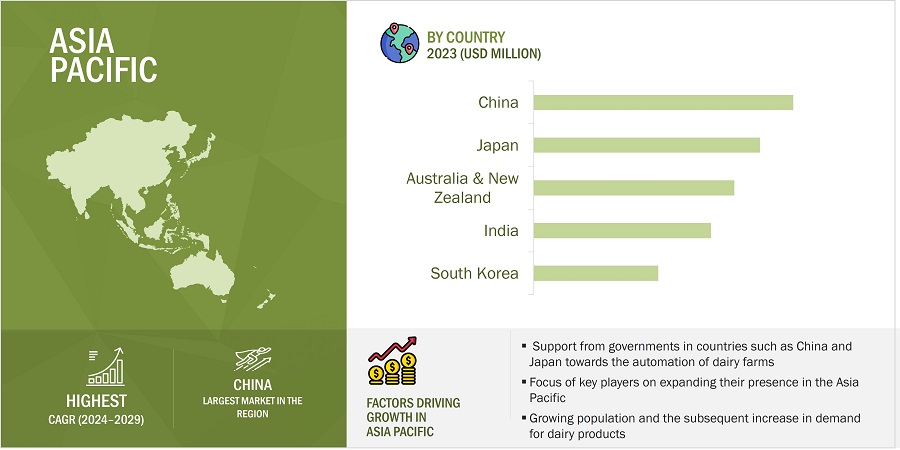
Milking Robots Market by Region
To know about the assumptions considered for the study, download the pdf brochure
The Asia Pacific region is expected to exhibit the highest growth rate in the global milking robots market due to several key factors. Rapid population growth in the region's emerging economies and the subsequent rise in the demand for milk and other dairy products is exerting pressure on the suppliers of dairy products to become more efficient and productive, thus pushing the sales of milking robots and other automated milking solutions upward. However, the availability of inexpensive labor, higher input costs and the lack of large-scale dairy farms are some of the major factors that adversely affect the adoption of milking robots in the region. Rapid economic growth, and surging demand for milk in countries such as China, India, Malaysia, Japan, and Singapore are expected to drive the market growth in the region. This increased demand for milk products has triggered the adoption of automated milking systems on dairy farms in this region. Furthermore, automated milking rotaries (AMRs) reduces the amount of manual labor required in the milking process on dairy farms, thereby reducing the labor cost. With rapid industrialization, milk consumers are becoming aware of the quality and the type of dairy products they are consuming. Hence, dairy farm owners are adopting automated milking systems for increasing production to meet the growing demand for milk.
Key Market Players
Lely (Netherlands), GEA Group AG (Germany), DeLaval (Sweden), Nedap Livestock Management (Netherlands), and BouMatic (US). Other key players include Fullwood JOZ (UK), Milkomax solutions laiteres inc. (Canada), System Happel GmbH (Germany), Waikato Milking Systems NZ LP (New Zealand), AMS Galaxy USA (US), and Dairymaster (Ireland) are some of the key players in the milking robots companies.
Get online access to the report on the World's First Market Intelligence Cloud
- Easy to Download Historical Data & Forecast Numbers
- Company Analysis Dashboard for high growth potential opportunities
- Research Analyst Access for customization & queries
- Competitor Analysis with Interactive dashboard
- Latest News, Updates & Trend analysis
Request Sample Scope of the Report
Get online access to the report on the World's First Market Intelligence Cloud
- Easy to Download Historical Data & Forecast Numbers
- Company Analysis Dashboard for high growth potential opportunities
- Research Analyst Access for customization & queries
- Competitor Analysis with Interactive dashboard
- Latest News, Updates & Trend analysis
|
Report Metric |
Details |
|
Market Size Availability for Years |
2020–2029 |
|
Base Year |
2023 |
|
Forecast Period |
2024–2029 |
|
Forecast Units |
Value (USD Million/ Billion) |
|
Segments Covered |
By system type, offering, herd size, actuators, species, and region |
|
Geographies Covered |
North America, Europe, Asia Pacific, and Rest of the World |
|
Companies Covered |
Lely (Netherlands), GEA Group AG (Germany), DeLaval (Sweden), Nedap Livestock Management (Netherlands), BouMatic (US) 26 companies profiled |
Milking Robots Market Highlights
This research report categorizes the milking robots market based on product, touch technology, aspect ratio, screen size, resolution, industry, application, and region.
|
Segment |
Subsegment |
|
By System Type: |
|
|
By Offering: |
|
|
By Herd Size: |
|
|
By Species: |
|
|
By Actuators: |
|
|
By Region: |
|
Recent Developments
- In October 2023, Lely, the robot manufacturer, and Konrad Pumpe GmbH, the innovative specialist in plant engineering, united forces through an official partnership. Lely integrated Konrad Pumpe GmbH's dosing systems into their feed range, available via Lely Centers. This expanded Konrad Pumpe GmbH's reach and empowered Lely Centers to offer farmers enhanced capabilities with the Lely Vector feeding system.
- >
- In August 2023, GEA and Unilever teamed up to diminish greenhouse gas emissions (GHG) in dairy farming by deploying GEA's new manure enricher solution, ProManure E2950. In the initial phase, four units were installed on Dutch farms supplying Unilever with milk. Over a year, data from these systems was scrutinized to gauge their impact on Unilever's carbon footprint. This evaluation allowed Unilever and GEA to assess and expand the system's potential to substantially curb GHG emissions throughout the milk production process, thereby enhancing Unilever's sustainability along its value chain.
- In June 2023, Fullwood JOZ extended its exclusive collaboration with Mueller, broadening its range to include cooling solutions for milking robots and traditional milking systems.
- In September 2022, Lely unveiled the next iteration of Lely Juno, their automated feed pushing solution, following the 2008 debut of the first-generation Juno. Evolving over time, it achieved market leadership with 13,000+ units across 45 countries. Continuous improvements focused on reducing running costs for end users.
- In August 2022, DeLaval launched an advanced milking technology, Flow-Responsive Milking. The technology reduces the milking time up to 10% by altering the vacuum applied to the milk flow profile.
Frequently Asked Questions (FAQs):
Which are the major companies in the milking robots market? What are their major strategies to strengthen their market presence?
The major companies in the milking robots market are – Lely (Netherlands), GEA Group AG (Germany), DeLaval (Sweden), Nedap Livestock Management (Netherlands), and BouMatic (US). Other key players include Fullwood JOZ (UK), Milkomax solutions laiteres inc. (Canada), System Happel GmbH (Germany), Waikato Milking Systems NZ LP (New Zealand), AMS Galaxy USA (US), and Dairymaster (Ireland).
What are the major strategies adopted by key players to strengthen their market presence?
The major strategies adopted by these players are product launches & developments, partnerships, and collaborations.
What are the new opportunities for emerging players in the milking robots market?
New prospects in the milking robots market are driving significant global growth. The increased awareness of their benefits like efficiency, better animal care, improved milk quality, and data-driven insights, alongside technological advancements, underscores this momentum. Moreover, rising demand for organic dairy, government support, labor cost concerns, and emerging opportunities such as AI integration and new market exploration further propel this growth. Companies innovating in these areas stand to capitalize on the burgeoning market ahead.
Which system type is likely to drive the milking robots market growth in the next five years?
The single-stall unit is dominating the market during the forecast period. These units offer a more affordable entry point for farmers seeking to adopt robotic milking technology, making it accessible to a wider range of dairy operations, including smaller and mid-sized farms. Moreover, they provide a flexible and scalable solution, allowing farmers to expand their robotic milking infrastructure as needed gradually. The single-stall unit's capacity to integrate advanced technologies, such as AI-driven monitoring and data collection, enhances its appeal by offering efficient and precise milking processes while contributing to improved herd management. This adaptability and technological integration have significantly contributed to the single-stall unit's role in propelling the growth of the milking robots market.
Which region will likely offer lucrative growth for the milking robots market by 2030?
During the forecast period, Europe is likely to dominate the market share of milking robots, primarily driven by the extensive adoption of dairy farm automation in Western Europe. Key players like DeLaval (Sweden), Dairymaster (Ireland), and Lely (Netherlands) play a significant role in the milking robots market across the continent, supplying their technology to global end-users. The market growth in Europe can be attributed to the rising automation trend and the presence of multiple influential market participants. Across Europe, a considerable segment of farms maintains a significant scale, managing herds that surpass 1000 in number. These larger-scale operations often leverage advanced technologies and streamlined processes to manage their substantial herds efficiently. Such farms typically benefit from economies of scale, allowing for optimized operations, from feeding and housing to healthcare and milking. Their size necessitates sophisticated management systems, including robust infrastructure and specialized equipment like milking robots, enabling efficient handling of the large herd size while meeting modern agricultural demands. Due to their scale and production capacity, these farms often play a substantial role in supplying dairy products, contributing significantly to the regional and sometimes international dairy market.
To speak to our analyst for a discussion on the above findings, click Speak to Analyst
The study involved four major activities in estimating the market size of milking robots. Exhaustive secondary research has been carried out to collect information on the market, the peer markets, and the parent market. Both top-down and bottom-up approaches have been employed to estimate the total market size. Market breakdown and data triangulation methods have also been used to estimate the market for segments and subsegments.
Secondary research
In the secondary research process, various secondary sources have been referred to for identifying and collecting information relevant to this study on the commercial touch displays market. The secondary sources included the International Federation of Robotics (IFR), FAOstat, International Livestock Research Institute (ILRI), annual reports, press releases, and investor presentations of companies; white papers, certified publications, and articles by recognized authors; directories; and databases.
The global size of the milking robots market has been obtained from the secondary data available through paid and unpaid sources. It has also been determined by analyzing the product portfolios of the leading companies and rating them based on the quality of their offerings.
Secondary research has been used to gather key information about the industry's supply chain, the market’s monetary chain, the total number of key players, and market segmentation according to the industry trends to the bottom-most level, geographic markets, and key developments from both the market- and technology-oriented perspectives. It has also been conducted to identify and analyze the industry trends and key developments undertaken from both the market- and technology perspectives.
Primary Research
In the primary research process, various primary sources have been interviewed to obtain qualitative and quantitative information about the market across four main regions—Asia Pacific, North America, Europe, and the Rest of the World (the Middle East & Africa, and South America). Primary sources from the supply side include industry experts such as CEOs, vice presidents, marketing directors, technology directors, and other related key executives from major companies and organizations operating in the milking robots market or related markets.
After completing market engineering, primary research was conducted to gather information and verify and validate critical numbers from other sources. Primary research has also been conducted to identify various market segments; industry trends; key players; competitive landscape; and key market dynamics, such as drivers, restraints, opportunities, and challenges, along with key strategies adopted by market players. Most primary interviews have been conducted with the market's supply side. This primary data has been collected through questionnaires, emails, and telephonic interviews.
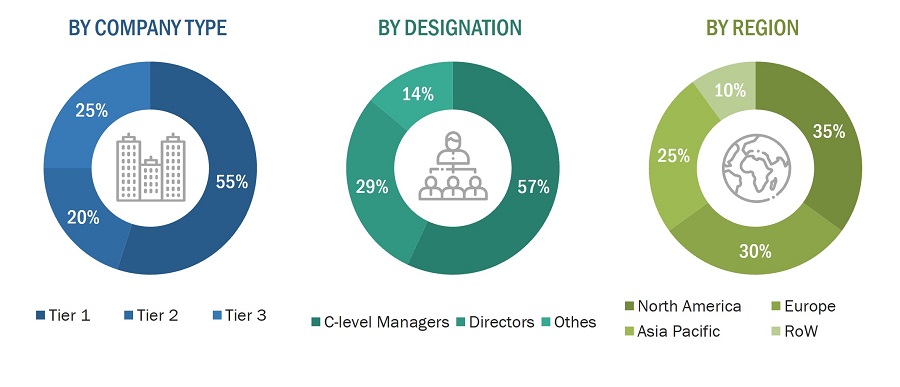
To know about the assumptions considered for the study, download the pdf brochure
Market Size Estimation
In the complete engineering process, both top-down and bottom-up approaches and several data triangulation methods have been used to estimate and validate the size of the overall commercial touch displays market and other dependent submarkets. Key players in the market have been identified through secondary research, and their market positions in the respective geographies have been determined through both primary and secondary research. This entire procedure includes studying top market players' annual and financial reports and extensive interviews with industry leaders such as CEOs, VPs, directors, and marketing executives for key insights (qualitative and quantitative).
All percentage shares and breakdowns have been determined using secondary sources and verified through primary sources. All the possible parameters that affect the markets covered in this research study have been accounted for, viewed in detail, verified through primary research, and analyzed to obtain the final quantitative and qualitative data. This data has been consolidated and supplemented with detailed inputs and analysis from MarketsandMarkets and presented in this report.
Global Milking Robots Market Size: Bottom-Up Approach

Global Milking Robots Market Size: Top-Down Approach

Data Triangulation
After arriving at the overall market size from the market size estimation process explained above, the total market has been split into several segments and subsegments. Data triangulation has been employed to complete the market engineering process and arrive at the exact statistics for all segments and subsegments. The data has been triangulated by studying various factors and trends from the demand and supply sides. Along with this, the market has been validated using both the top-down and bottom-up approaches.
Market Definition
Milking robots are automatic milking systems deployed on dairy farms for reducing labor costs and enhancing milk quality and yield. Milking robots comprise a milking machine, a teat position sensor, a robotic arm for automatic teat cup application, and a gate system for controlling cow traffic. Milking robots are designed to make dairy farms more efficient and profitable without the help of manual labor. The milking robots market encompasses the industry involved in designing, producing, and implementing automated systems used for milking dairy animals, primarily cows. These robots are equipped with sensors, mechanical arms, and software to facilitate the autonomous milking process. They operate by identifying and attaching to the udders, milking the cows, and often incorporating features such as cleaning and monitoring cow health. The market includes various technological advancements, such as integration with data analytics and AI for optimizing milking efficiency and herd management. It caters to dairy farms seeking automation solutions to enhance productivity, animal welfare, and operational efficiency in milk production.
Key Stakeholders
- Technical universities
- Research institutes and organizations
- Market research and consulting firms
- Intellectual property vendors
- Dairy farm owners
- IT service providers
- System integrators
- Consulting service providers
- Network service providers
- Software service providers
- Data center vendors
- Internet service providers (ISPs)
- Milking robots/automated milking systems research labs
- Associations related to milking robots/automated milking robots
Report Objectives
- Define, analyze, and forecast the milking robots market, in terms of value, segmented based on offering, system type, herd size, and region
- Define, analyze, and forecast the milking robots market, in terms of volume
- Forecast the market size for various segments with respect to 4 main regions: North America, Europe, Asia Pacific, and Rest of the World
- Provide detailed information regarding the major factors (drivers, restraints, opportunities, and challenges) influencing the growth of the milking robots market
- Study the complete value chain and related industry segments and perform a value chain analysis of the milking robots market
- Strategically analyze the micromarkets1 with respect to individual growth trends, prospects, and contributions to the total market
- To analyze industry trends, pricing data, patents and innovations, and trade data (export and import data), regulatory environment, Porter’s five forces analysis and the ecosystem related to the milking robots market
- Analyze opportunities in the market for various stakeholders by identifying the high-growth segments of the milking robots market
- Strategically profile the key players and comprehensively analyze their market position in terms of ranking and core competencies2, along with detailing the competitive landscape for the market leaders
- To analyze competitive developments such as product launches/developments, expansions, acquisitions, and research and development (R&D) activities carried out by players in the milking robots market
Available customizations:
With the given market data, MarketsandMarkets offers customizations according to the specific requirements of companies. The following customization options are available for the report:
- Detailed analysis and profiling of additional market players (up to 5 players) based on various blocks of the supply chain


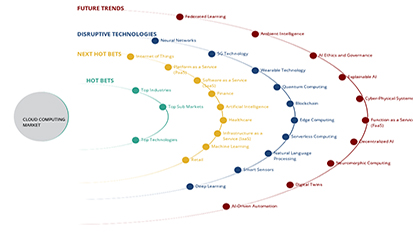

 Generating Response ...
Generating Response ...







Growth opportunities and latent adjacency in Milking Robots Market
We have already achieved first successes in this market and would like to increase our network and awareness in this area. We are the pioneers with oil-free scroll compressors and want to finally enter the market and support the success of milking robots. What data is available in your report for milking robots ? Have you included country level data for milking robots.